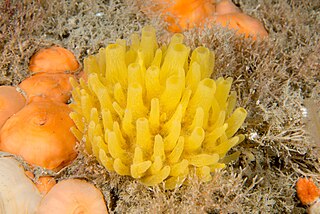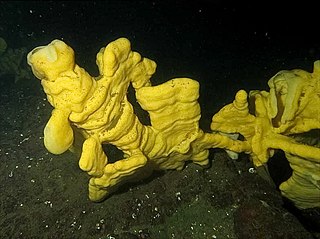
Polymastia is a genus of sea sponges containing about 30 species. These are small to large encrusting or dome-shaped sponges with a smooth surface having many teat-shaped projections (papillae). In areas of strong wave action, this genus does not grow the teat structures, but instead grows in a corrugated form.

The cloud sponge(Aphrocallistes vastus) is a species of sea sponge in the class Hexactinellida. It is a deep-water reef-forming animal. The species was first described by F.E. Schulze in 1886.

Auletta is a genus of sponges in the family Bubaridae.
Cladorhiza caillieti is a carnivorous sponge of the family Cladorhizidae described in 2014 from specimens collected from the Juan de Fuca Ridge off the coast of Vancouver Island. It feeds on small crustaceans such as amphipods and copepods. C. caillieti is an elongate, bottlebrush-shaped sponge with filaments projecting from a main stem, and ranges from 7 to 9 cm in height. The specific epithet honors Dr. Gregor M. Cailliet of the Moss Landing Marine Laboratories.
Chonelasma oreia is a species of sea sponge first found at the bottom of shelf, canyon and seamounts of the west coast of Washington, British Columbia and the Gulf of Alaska.

Euplectellidae is a family of glass sponges (Hexactinellids) belonging to the order Lyssacinosa, first represented in the Ordovician fossil record, substantially older than molecular estimates of the clade's age.

Rossellidae is a family of glass sponges belonging to the order Lyssacinosa. The family has a cosmopolitan distribution and is found at a large range of depths.

Caulophacus is a genus of glass sponges belonging to the subfamily Lanuginellinae.

Caulophacus elegans is a species of glass sponges belonging to the subfamily Lanuginellinae. The type specimen has been found in Central Kuroshio Current, near Japan.

Staurocalyptus is a genus of sponge. It was circumscribed in 1897 by Isao Ijima.
Acanthascus is a genus of sponges in the family Rossellidae. Species include:
Amphidiscella is a genus of sea sponge in the family Euplectellidae.
Sceptrulophora is an order of hexactinellid sponges. They are characterized by sceptrules, a type of microsclere with a single straight rod terminating at a bundle of spines or knobs. An anchor- or nail-shaped sceptrule is called a clavule. A fork-shaped sceptrule, ending at a few large tines, is called a scopule. A broom-shaped sceptrule, ending at many small bristles, is called a sarule.

Farrea is a genus of glass sponges in the family Farreidae.
Claviscopulia is a genus of glass sponge in the family Farreidae.
Chonelasmatinae is a subfamily of sea sponge in the family Euretidae.
Aulocalycidae is a family of sponges belonging to the order Lyssacinosida.
Saccocalyx is a genus of sponge belonging to the family Euplectellidae.

Latrunculia is a genus of demosponges. It is well known for the diverse array of chemical compounds found in its species, including the latrunculins, which are named after this genus. Many of these are medically important, including anti-cancer compounds such as discorhabdins.
Michelle Kelly, also known as Michelle Kelly-Borges, is a New Zealand scientist who specialises in sponges, their chemistry, their evolution, taxonomy, systematics, and ecology.








